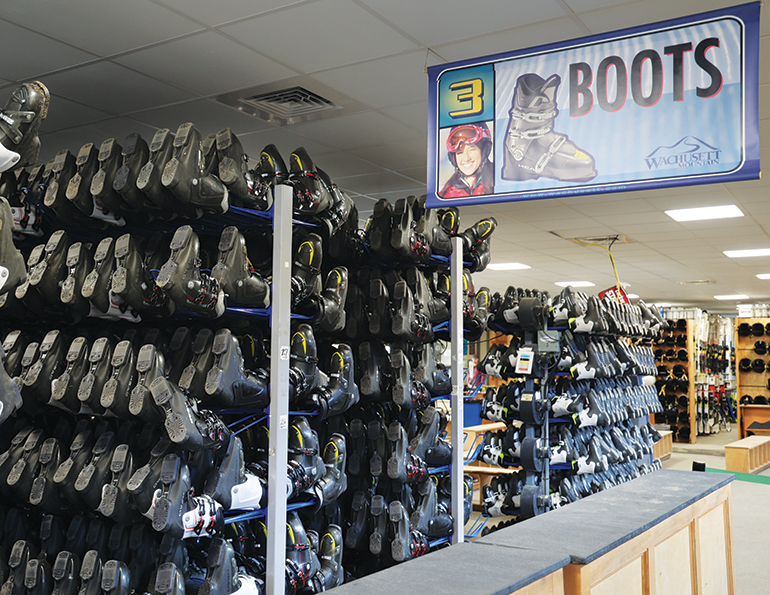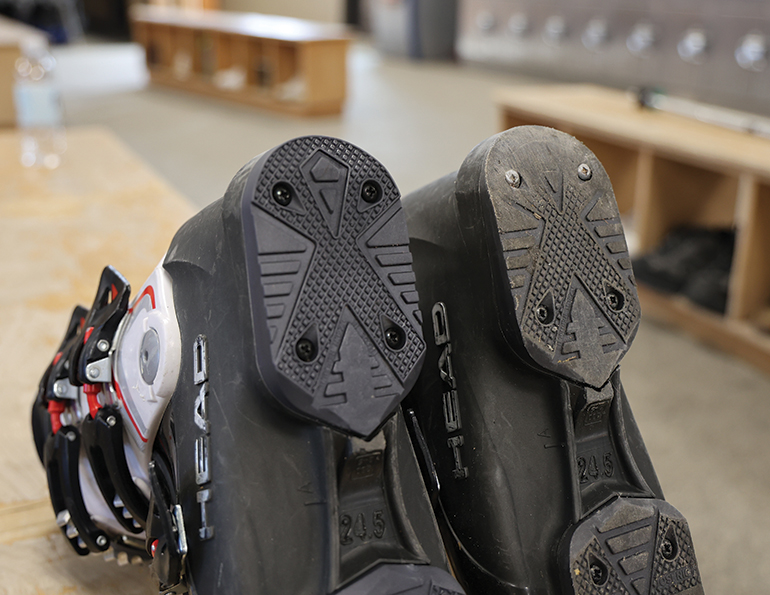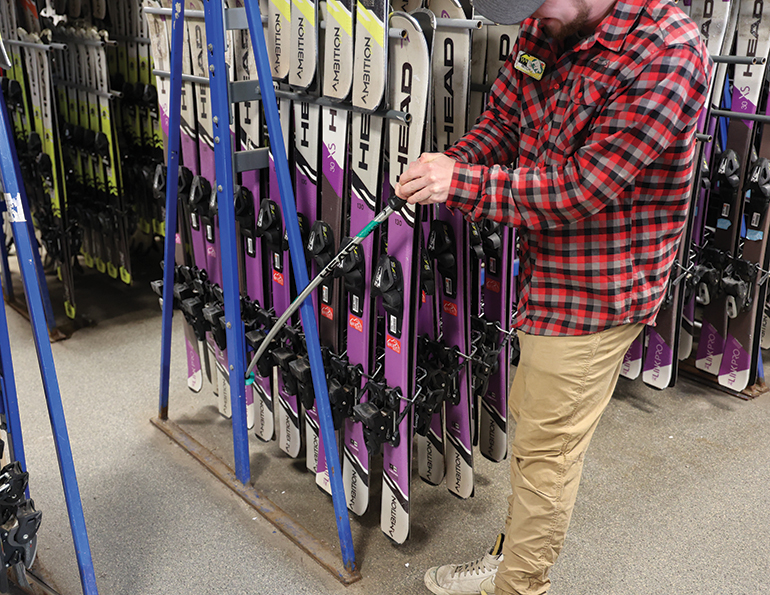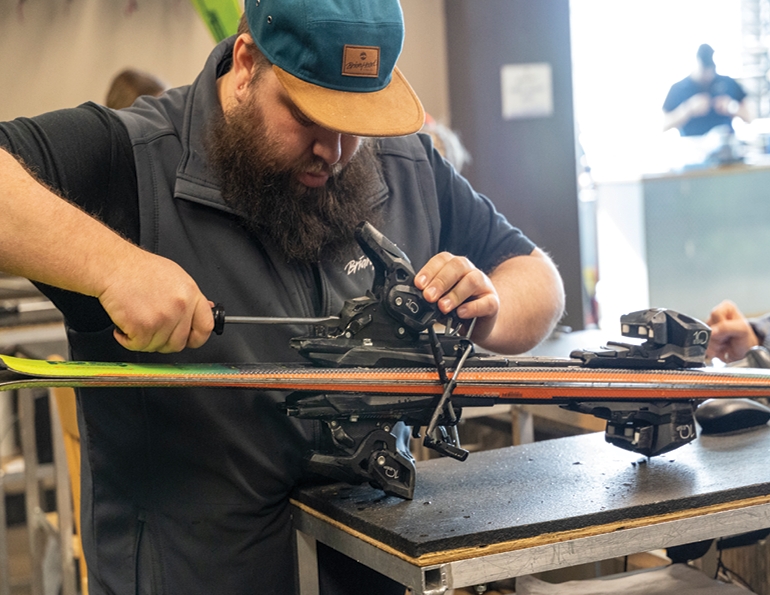Heed the old adage: Don’t slay the golden goose. For most ski areas, the rental fleet is a gaggle of golden geese that represents a significant revenue stream during the course of a season. For that reason, it is a gaggle worth nurturing well, with a thorough and well-planned maintenance program.
Put another way, don’t allow your rental fleet to die a slow death due to neglected maintenance. That’s especially true when it comes to off-season prep and storage—which shouldn’t simply be a one-time-a-year deal, but a long punctuation mark on a regular maintenance program ongoing throughout the ski season.
The benefits of well-maintained rental equipment should be obvious. Well-maintained equipment lasts longer, though it might not result in the significant extension of the usable life of a piece of gear. However, it will likely reduce the percentage of equipment that must be chucked annually because it is broken, damaged, or is in some other way unsuitable for use.
Most of all, says Todd Carroll of Wintersteiger, when it comes to well-maintained equipment, “where you move the needle the most is in customer satisfaction and return business.”
For recommendations on off-season care of rental gear, SAM turned two resorts, Wachusett, Mass., and Brian Head, Utah, that do an exemplary maintenance job with their sizeable rental fleets.
 Left to right: Rental skis and boots neatly stored at Brian Head, Utah; Clean rental helmets hanging out at Wachusett, Mass.
Left to right: Rental skis and boots neatly stored at Brian Head, Utah; Clean rental helmets hanging out at Wachusett, Mass.
ONGOING CARE AND TRACKING
The first thing to do before putting the fleet to bed at the end of the season is to inspect everything thoroughly. Inspection, like other aspects of annual maintenance, shouldn’t be a once-a-year process; inspection should be done regularly during the course of a season. That said, it is not always practical to do a thorough inspection every time a piece of equipment returns from an outing on the slopes. Post-season spring provides the opportunity to catch up.
Wachusett’s program. Take Wachusett, with a fleet of 2,200 skis, 800 snowboards, 1,600 helmets, and 3,000 boots. (Wachusett uses Head’s BYS system for its rental fleet.) The busy Boston-exurbia resort operates with three daily sessions—morning, afternoon, and night—meaning equipment is flying in and out of the door in a continuous stream during its typical 120-day season. Before a pair of skis hits the slopes for its second or third use of the day, the rental staff might not have time to check carefully for a core shot, a damaged edge, dry bases, or a wonky boot buckle.
 Wachusett has 3,000 rental boots that are managed using an in-house software program that tracks maintenance and use.
Wachusett has 3,000 rental boots that are managed using an in-house software program that tracks maintenance and use.
Nevertheless, the resort checks, cleans, and refurbishes equipment frequently and regularly during the course of the season. In doing so, it keeps a meticulous maintenance record, using a software program developed in-house, according to Wachusett vice president Carolyn Stimpson, who adds that proper record keeping is foundational to a good maintenance program. When the resort begins rotating equipment out of service starting in March, with business winding down before the usual early-April closing, the rental crew knows exactly where things stand maintenance-wise with each piece of gear.
 Techs at Wachusett compare boot bases to assess wear and tear. Baseplates must be replaced after a certain amount of use to properly interface with bindings.
Techs at Wachusett compare boot bases to assess wear and tear. Baseplates must be replaced after a certain amount of use to properly interface with bindings.
Brian Head’s approach. At Brian Head, the rental crew begins its off-season prep a bit later, in mid-April—“after we vacate the place for two weeks,” says rental manager Chuck Driggers. Like Wachusett, Brian Head uses a computer program to track all rental maintenance throughout the season, so the condition of each piece of equipment is well documented when post-season inventory is taken and the rental staff “inspects for repairability,” according to Driggers.
REPLACEMENT, RESALE, AND RETIREMENT
Like some other resorts, Brian Head rotates though its rental skis and boots on a three-year basis, replacing roughly a third of the inventory every year. Snowboards last longer, says Driggers, typically being replaced every six or seven years, while helmets are considered usable for up to two years. Usable equipment that is regularly circulated out of commission is sold to a Salt Lake City company at rock-bottom prices—e.g., $15 for a pair of skis.
About 10 percent of the Brian Head ski and snowboard fleet is discarded annually because it is deemed to be damaged beyond repair or otherwise unusable. Any indication of blood on a boot or helmet liner, for example, means automatic relegation to the discard pile.
Wachusett sends out “dead” equipment for recycling, but manages to squeeze a little more revenue out of the usable gear it pulls regularly from the fleet by staging a rental-gear sale, in which about 300 skis and snowboards are sold every fall.
PRE-STORAGE INSPECTION AND REPAIR
What exactly is the rental team looking for in their post-season inspections? For skis and snowboards, base and edge damage is obviously the principal concern. Before pre-storage tuning, any necessary base repair (i.e., core shots) should be done. Broken or malfunctioning parts should be replaced before storage as well.
Be prepared. Maintaining a healthy supply (space permitting) of replacement parts and/or repair items for anything predictably subject to breakage or damage—e.g., boot buckles or ski-pole baskets—and, of course, a healthy supply of P-Tex is sensible in order to be prepared for any needed repairs before gear goes into storage.
One area that tends to see significant wear and tear, says Head’s Marshall Mayhew, is the interface between boots and bindings. Mayhew suggests that resorts make an estimate ahead of time of the number of heel and toe pieces on boots that typically need replacing every year. In terms of damaged parts, he suggests a particularly careful inspection (and repair) of binding AFDs, which can be out of position or broken.
Repairs are best done in the spring before storage, but some repairs can wait until fall if staffing or finances so dictate.
KEEPING IN TUNE
Both Wachusett and Brian Head conduct a thorough tuning and waxing of all skis and boards before putting them to bed for the summer. Brian Head uses a Grindrite machine to do the work (an older, non-computerized model, according to Driggers), while Wachusett goes with a Montana Challenge “tuning robot.” But the assembly-line-like process is essentially the same. Line up a rental-staff team and grind, tune, and wax. Grind, tune, and wax. Repeat again and again.
How long the process takes obviously depends at least partly on the number of staff committed to the project and the amount of rental equipment involved, but once the assembly line is set up and the work gets going, Driggers estimates that his team can do up to 180 pairs of skis a day. Wachusett rental manager Heidi Dow-Besse says the rental team churns through skis at a rate of roughly one pair every five minutes.
Wintersteiger’s Carroll suggests that a rate of 40 to 60 pairs an hour is possible “depending on what needs doing.” That calculation is presumably based on modern, computer-guided tuning equipment coming into play.
While Carroll says that leaving a thick, protective layer of storage wax on skis and snowboards might constitute a “best practices” approach, for most large rental operations it is not logistically practical. So, a straightforward wax job is the way to go, along with a basic tune.
Tuning skis and boards requires attention. Dow-Besse says that Wachusett applies a straight 90-degree edge and a one-degree base bevel; Head’s Mayhew recommends a two-degree side edge to go with a one-degree base bevel. (The Montana Challenge, among other modern tuning machines, can be set at fractions of a degree for anyone seeking fine-tuning precision.)
Carroll says that, when it comes to edge angles, it makes sense to go with the manufacturer’s recommendation. That’s especially true with snowboards, where tuning specs can vary given the variety of board shapes.
Binding settings should be dialed down to release spring pressure. Dow-Besse says that at Wachusett, adult bindings are brought down to a DIN 3 reading, and kids’ bindings to DIN 1.
For boots and helmets, cleaning with a soapy mix is one way to go. Driggers says that, at Brian Head, he avoids cleansers that might introduce potentially harmful chemicals. Instead, all Brian Head boots and helmets are sprayed with a citrus disinfectant—as they are in-season after every use—and are cleaned out with a shop vac before going into storage.
One last component of the equipment inventory worth mentioning is poles, which can take a beating in the hands of rental customers. Driggers says that Brian Head minimizes the problems and expense of re-straightening bent poles or replacing unusably damaged ones by investing in graphite poles. Although graphite is more expensive and more susceptible to breakage, Driggers believes that in the long run it is a cost-saver and less of a maintenance/repair hassle.
 Rental poles take a beating over the season. Here, a Wachusett rental tech straightens a bent one.
Rental poles take a beating over the season. Here, a Wachusett rental tech straightens a bent one.
WHERE TO STORE EQUIPMENT?
Carroll says that there are two approaches to storing rental gear: keeping gear in place in the rental room, and moving gear to a separate storage space. Both are equally common. Some resorts, of course, need the winter rental space for summer operations, e.g., for mountain-bike rentals.
Regardless, exactly where equipment is stored is less important than the environmental conditions in which it is stored. Simply put, dry and relatively cool is the way to go.
According to Carroll, rental boots are typically built with less expensive materials than regular retail gear, and hence are potentially subject to greater environmental degradation. That is why it is important, he says, to stash gear in a well-ventilated space. Flipping on fans or air conditioning from time to time to assure a dry climate doesn’t hurt either.
Wachusett keeps its rental gear in place for the summer and uses Advanced Racking Systems’ boot-drying racks throughout the year, including the off season. The dryers are turned on occasionally during summer storage to channel fresh air into all boots and keep liners from deteriorating or collecting mold.
FALL PREP
In the fall, another inspection is in order, to determine how well equipment has survived its summer somnolence. If necessary—due to oxidation on edges, indication of dry bases, base repairs, etc.—another run through the tuning machine might be needed.
Perhaps the most critical part of the pre-season prep, however, is a full round of binding tests representing phase one in a testing process that extends throughout the winter season. During the winter, Dow-Besse says that Wachusett conducts 200 binding tests every two weeks per an insurance requirement.
Rental equipment is then re-racked, if necessary, with the knowledge that it is clean, properly tuned, and ready to take on its assignment as a significant revenue producer. The golden geese are ready to fly again.






